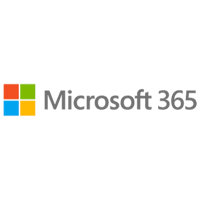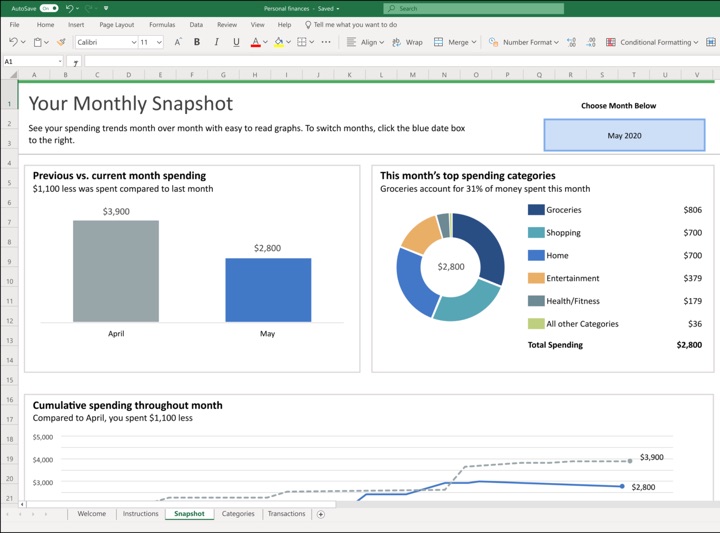
It’s not the classic Microsoft Money application (which I’m still asked about periodically), but Microsoft 365 Personal or Family subscribers can now download “Money in Excel” (free) which promises to help you manage your personal finances using Excel tools and the automated import of your transactions. Thanks to reader Motti for the tip. From their official blog:
Money in Excel is a dynamic, smart template and add-in for Excel that allows you to securely connect your bank, credit card, investment, and loan accounts to Excel and automatically import your transaction and account information into an Excel spreadsheet.
The service uses Plaid, a third-party company (recently acquired by Visa) to synchronize with all of your various financial accounts. You will have to provide the username and passwords for those accounts. (If you haven’t already, use a password manager so that you can maintain unique, strong passwords for each of your bank or brokerage accounts.)
You can do things like track your monthly spending by category, add up your net worth instantly, or get notified of selected transactions like big purchases or bank fees. Here is a screenshot:

Unfortunately, there doesn’t appear to be a way to access this premium template if you do not have a Microsoft 365 Personal or Family subscription ($70 to $100 annually). I am not a 365 subscriber myself, so I am unable to test this out further. I’d be interested to see if you are completely free to customize the Excel using all the imported data. That might work like the combination of Personal Capital and Google Sheets (also free) that I currently use to track my portfolio. If you try it, please let me know what you think in the comments or via Twitter @mymoneyblog.
 The Best Credit Card Bonus Offers – 2025
The Best Credit Card Bonus Offers – 2025 Big List of Free Stocks from Brokerage Apps
Big List of Free Stocks from Brokerage Apps Best Interest Rates on Cash - 2025
Best Interest Rates on Cash - 2025 Free Credit Scores x 3 + Free Credit Monitoring
Free Credit Scores x 3 + Free Credit Monitoring Best No Fee 0% APR Balance Transfer Offers
Best No Fee 0% APR Balance Transfer Offers Little-Known Cellular Data Plans That Can Save Big Money
Little-Known Cellular Data Plans That Can Save Big Money How To Haggle Your Cable or Direct TV Bill
How To Haggle Your Cable or Direct TV Bill Big List of Free Consumer Data Reports (Credit, Rent, Work)
Big List of Free Consumer Data Reports (Credit, Rent, Work)
I have a Microsoft 365 Enterprise license and was able to add the Money In Excel template, but when I try to use it I get a message that the add-in requires the latest version of Excel. I’m on the latest (Current Channel and all caught up on updates for Enterprise), but still get that message. I’m afraid that you might need a M365 Personal or Family version instead of a Work or School edition.
Thanks for trying that out and reporting back.
I have found that Tiller Money is the best spreadsheet solution for Google users. From what I cant see, Tiller offers a more robust template to track finances then Microsoft’s new platform. The only downside is they do not use Plaid as their 3rd-party provider. Here is a link to check it out: https://www.tillerhq.com/
Thank you for sharing this useful post.
Any suggestions on using google docs and sheets to avoid annual Microsoft subscription. Does anyone know if this is interchangeable with Microsoft excel and word? Sorry Jonathan making this post on this thread but I thought others may want to avoid the annual subscription.
Check the reply from “Edwaes” above.
I’ve used google docs for years with budgeting. I downloaded a excel spreadsheet from pearbudget.com in 2014 and then imported into google docs. Few tweaks and I was off and running.
Interested to know if you have to have an active 365 account to continue using the template or if you can subscribe for a month and download the template then continue using even if you don’t renew your subscription
Pretty sure the answer to that is yes. You have to login to your O365 account every time you want data updated. And I think the data is pulled from Plaid into the O365 cloud servers, and then from the cloud servers into your Excel workbook.
Thank you, Jonathan.
I am not a 365 subscriber myself either. $100/yr x 2yrs is the same $200 a person would pay outright for a standalone copy. Further, many features in the newer versions are either too advanced for majority of people(and not used), like data scraping or a polished button like Slicer (a feature found inside of a Pivot Table).
Also, there are completely free versions, such as Google Sheets or Libre Office.
I’ve got it active. I’ve been waiting for this to come out as I had put together my own financial spreadsheet and liked the idea of having this available minus all the ads that Mint and Personal Capital push.
Many of the tabs that are created are locked, but you are able to unlock if you wish and customize at will. There are a couple issues I’d like to see fixed, such as if I rename a entry that it updates all the other entries with that same name or changes their categories – it doesn’t.
The real issue for me however is a lack of accounts. HSBC isn’t available, and adding two separate American Express accounts results in an error.
I have an available license on my Family account if you’d like to trial it Jon.
I get similar information (and tons more like investment management) free using Personal Capital. I have over 10 bank accounts managed all in one place. Since you use Personal Capital as well, did you see any differences?
Seems to be some misinformation on what exactly comes with Microsoft 365 Family (Formerly Office 365). For $108.49 after tax per year, I get:
~ 5 people that can install Office on every one of their machines: Word, Excel, PowerPoint, Outlook, Publisher, Access
Which covers my desktop, my laptop, my iPad
Wife’s laptop, wife’s iPad
Son #1’s laptop, son #’1 iPad
Son #2’s iPad
And I have an open user account not currently assigned
That is a total of 8 devices today running all premium Microsoft Office products. (This was never possible prior to their new licensing arrangement.)
~ 1TB (1000GB) of Premium OneDrive space that currently has a full backup of my desktop, laptop, and iPad (And using the Office Lens app, every receipt I’ve received the last four years with OCR to find receipts for expense reports)
~ 60 minutes of free Skype calling per month
~ And finally, now with this update, all four of my family members have their own access to new premium office templates including the Microsoft 365 Money template that we are talking about on this thread.
As I said in my previous post, Money doesn’t do anything today that Mint or Personal Capital doesn’t. Except that I don’t get called by Microsoft offering financial advice or to talk to my advisor like Personal Capital does. And I don’t get shown advertisements for credit cards I may want or already have like Mint does.
The biggest reason I was looking forward to this template was to have excel tabs next to my existing tabs that I can reference. For instance, I have a tab going that reflects overall monthly income between my wife and I, active loans, loan payments, interest amounts, and future finanical plans – now a lot of those totals don’t need to be manually updated by looking at Mint or Personal Capital, it will simply reference a cell from the Money tab and be constantly updated.
Knowing Microsoft, some quirks I have with it now will be rectified in the coming months. I’m sure there are services or templates for Google Sheets – but I personally hate how slow it is. Once HSBC is added as a bank, I will have the 25 or so accounts currently active for me available within Money. My wife will continue to use Mint on a regular basis to make sure some of her clients have paid or that charges have not been made that shouldn’t have. I will use Money for a longer-term view and planning purposes.
Hope this helps, and Jon, let me know if you want to trial it with my fifth open user account.
Best, Michael
Thank you Michael for the helpful information and also for your generous offer of the user account. I must politely decline as even if it filled my needs I probably wouldn’t be willing to pay $10 a month for it. (I can definitely see the value for many people, especially given your explanation, just not me. Maybe when the kids are old enough to use Word/Excel for school.) If I am really motivated, I can sign up for the 30-day free trial.
Admittedly, I’m old, but I just wish they would refresh the old desktop software. I continue to use it, even after 24 years, and it’s been free to use for at least 12 years. It’s still a great program. The huge downside is that it’s next to impossible to automatically download transactions, which is a turn-off for just about everybody. I don’t make all that many transactions, so it’s not a big problem for me. I use an external utility from Gaier Software to automatically update stock, ETF, and mutual fund prices.
See Jonathan’s post from 5/20/2010 (yes, 2010) if interested.
Michael T Anderson, you do know you can use Google Sheets for Free to update the stock/ETF prices .?
The function is GoogleFinance(B3,”price”), where cell B3 is a ticker symbol.
I found this free template, you can make a copy and use it. I haven’t verified if functions are ok and the template is secure. Always be cautions when using others templates for security reasons. However, the spreadsheet looks ok and Google does ran antivirus on all of its cloud stored documents.
https://docs.google.com/spreadsheets/d/1Ajox_mGj_prTqfIWSSF1xcaDEBm6ZuZZDInZ1Es-_bM/edit#gid=4
This Google Sheets doc got started from this site: https://investmentmoats.com/stock-market-commentary/portfolio-management/introducing-our-free-stock-portfolio-tracker-spreadsheet/
Sam, are google docs interchangeable with Microsoft word and excel? I just bought a new computer and I don’t want to pay a subscription to Microsoft.
Hoping my Microsoft docs on flash drive can be read once I download google sheets and docs on new computer.
It seems like a very basic start at something that I hope they really expand. The biggest limitation is that it doesn’t appear to allow you to manually add any accounts/transactions. So if they don’t support one of your financial institutions you can’t include them in the data. And I have 4 that Plaid doesn’t currently support. (Well they do support one of them but it is currently broken with no ETA for when it will be fixed, and it is my primary account.)
It also doesn’t bring any detail in for your investment accounts. Just the balance. No holdings or transactions.